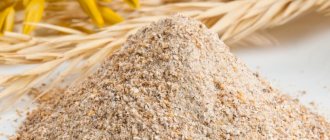Gelatin is a widely known product. Many housewives use it in cooking. Everyone knows such products as marmalade, jelly, aspic, and all kinds of mushroom and meat snacks.
| The nutritional value |
| Serving Edible gelatin 100 g |
| Amount per serving |
| Calories 62 Calories from fat 0 |
| % Daily value* |
| Total fat 0 g 0% |
| Cholesterol 0 mg 0% |
| Sodium 75 mg 3% |
| Potassium 1 mg 0% |
| Total carbohydrates 14.19 g 5% |
| Sugar 13.49 g |
| Dietary fiber 0 g 0% |
| Proteins 1.22 g 2% |
| Phosphorus 2% |
| * Calculation for a daily diet of 2000 kcal |
The ratio of BZHU in the product
Source: depositphotos.com
How to burn 62 kcal?
| Walking | 16 min. |
| Jogging | 7 min. |
| Swimming | 5 minutes. |
| Bike | 9 min. |
| Aerobics | 12 min. |
| Household chores | 21 min. |
Of course, gelatin brings considerable benefits to our body. Indeed, even in folk medicine it is used to treat certain diseases. But due to the high calorie content of gelatin, nutritionists do not recommend getting too carried away with eating products based on it.
Description
Gelatin is a mixture of protein substances of animal origin. It is obtained from bones, cartilage, tendons, that is, from products rich in collagen, by prolonged boiling. The most common sources of gelatin are cattle and fish. Edible gelatin, as a rule, has a light yellow tint, and it has no smell or taste.
From Latin the word “gelatin” is translated as “frozen.” This name can be easily explained by all the known properties of this product.
Most often you can see this product on sale in the form of small crystals or plates.
The composition of gelatin is dominated by a large amount of proteins (about 85%) and collagen. It is these substances that contain the main beneficial properties of gelatin.
Gelatin was patented by engineer Peter Cooper in 1845. However, for the next few decades the engineer’s invention was not popular. People simply could not understand what exactly the benefits of gelatin were and how this product should be used in general. But soon another scientist, Pearl Waite, invented jelly. From this moment on, gelatin finally gained well-deserved popularity and began to be widely used in cooking.
Today, many different delicious dishes are prepared from it. To make anything with gelatin, you must first let it swell in cold water and dissolve it in warm liquid.
This product has also found its application in pharmaceuticals. It is added in the production of candles and capsules. It is also used in the production of photographic paper and film, and is often added to the production of cosmetics: shampoos, balms and masks.
Gelatin: benefits and harm for hair
Gelatin hair masks are a huge success among girls. This wonderful product has proven itself only on the positive side, and after the home lamination procedure, the hair became elastic, shiny and “alive”. The benefit of gelatin as a mask is that it nourishes the hair along the entire length, and the collagen and proteins contained in it envelop each hair, protecting it from the negative effects of styling products and harmful factors.
To prepare the mask you need gelatin, water and any hair care product (mask or good balm). First you need to soak the gelatin in water, and when it increases in volume, add a mask (balm) to it and apply it to your hair. For the best effect, the head should be wrapped in a thin film, wrapped in a towel and left for one hour. Then rinse off with cool water.
Homemade gelatin-based lamination had only positive reviews. The harm of gelatin as a hair mask is minimal, and only some women noticed that after repeated such a procedure, their hair became stiffer and a little tangled.
Gelatin has neither odor nor taste. It is a crystallized powder that is used to thicken various dishes. At its core, it is an animal protein with special properties, a kind of extract from tendons, bones, animal and fish skins. Edible gelatin is actively used by culinary specialists around the world both in the preparation of some appetizers and main courses, and for desserts. Many claim that it is beneficial to human health, while some, on the contrary, talk about the harm that it can cause.
Composition and calorie content of gelatin
The main component of the product is collagen. In addition, gelatin contains many proteins, water, amino acids, fats, vitamin PP, ash, carbohydrates, macro- and microelements such as magnesium, potassium, sodium, iron and phosphorus.
Gelatin contains two important amino acids: proline and hydroxyproline, which have the most positive effect on cartilage and connective tissue, promoting their development, preservation and restoration.
The calorie content of gelatin per 100 g of product is 355 kcal, and nutritional value:
- Proteins – 87.2 g;
- Carbohydrates – 0.7 g;
- Fats – 0.4 g.
Harm of gelatin
There is no harm from gelatin, but this product in excess is contraindicated for people suffering from oxaluric diathesis. This is due to the fact that it, like sorrel, lettuce, spinach, chocolate and cocoa, is classified as oxalogens, and their consumption in large quantities is undesirable in case of disorders of water-salt metabolism and urolithiasis.
In very rare cases, gelatin can cause an allergic reaction.
Gelatin is a mixture of protein bodies of animal origin - a jelly-like substance formed by boiling tendons, ligaments, bones and some other tissues that contain collagen (protein) in water.
Gelatin is used:
- in medicine as a source of proteins for the treatment of various nutritional disorders;
- in pharmacology - for the production of capsules and suppositories;
- in the food industry for the production of confectionery products - jelly, marmalade, etc.
Gelatin is also used in the production of ice cream to prevent sugar crystallization and reduce protein coagulation.
Dry food gelatin is colorless or light yellow, tasteless and odorless. Molecular weight above 300,000; It swells strongly in cold water and dilute acids, but does not dissolve. The swollen gelatin dissolves when heated, forming a solution that hardens into a jelly.
Calorie content of gelatin
Edible gelatin has a huge amount of proteins, and its calorie content is 355 kcal per 100 g. Consuming this product in large quantities can lead to extra pounds.
Nutritional value per 100 grams:
Benefits of gelatin
Gelatin is well absorbed by the body and does not cause increased secretion of the digestive glands, so it is often included in dietary foods.
It is useful to use it for bone injuries, for example, when cracks and fractures form, as it promotes their rapid fusion and quickly restores joint tissue after injury. Regular consumption of gelatin is recommended for elderly people suffering from diseases of the musculoskeletal system, such as osteochondrosis and arthritis.
The beneficial properties of gelatin for hair and nails have been noted, so it is often used as a component for masks and baths.
For internal bleeding, it is recommended to take jellies and mousses that contain gelatin, as it promotes blood clotting.
The amino acids included in its composition give gelatin properties that strengthen the heart muscle, promote mental activity and strengthen the body's immune system.
Vitamins and microelements of gelatin
Gelatin contains beneficial
and the necessary amino acid - glycine, which provides the body with energy and affects mental activity, as well as alanine, aspartic and glutamic acids, which improve metabolism, strengthen the heart muscle and are a source of energy for the central nervous system.
Gelatin contains trace elements - phosphorus, calcium and sulfur, as well as proline and hydroxyproline, necessary for the connective tissues of the body.
Therefore, for bone fractures, dishes with gelatin are recommended to help the bones heal faster. Edible gelatin
is used in the production of canned fish and meat, wines, jellies, ice cream, for the preparation of creams, jellied dishes, and confectionery. In ice cream production, gelatin is used to reduce protein coagulation and prevent sugar crystallization. Eating dishes with gelatin, as mentioned above, helps not only with bone fractures, but also with osteochondrosis, arthritis and poor blood clotting.
Gelatin is good for skin, hair and nails. Gelatin baths are used to strengthen nails.
To Reap the Benefits of Gelatin
, include in your diet those dishes where it is present: aspic, brawn, candied fruits, mousses, jellies, marmalade, marshmallows, soufflé. But you shouldn’t get too carried away with this, since the sweets themselves can cause more harm to the body. You can prepare dessert: "".
In technology
gelatin is used for sizing higher grades of paper, making artificial pearls, banknotes, and paints.
In medicine
it is used as a hemostatic agent and as a source of protein to treat nutritional disorders.
In pharmacy
it is used to make capsules containing a single dose of medicine, as well as suppositories.
In the photo and film industry, gelatin
found application for the preparation of emulsions in the photosensitive layer on film and photographic paper.
How to take gelatin
This product can enter the human body along with a variety of foods, with medications, and it can also be taken directly in diluted form. It is believed that the body needs approximately 1-2 tablespoons of gelatin daily. As a rule, it is taken on an empty stomach. This daily intake will protect against many diseases and also improve your appearance. If the product is taken in dry form, it should be washed down with a glass of warm water with vitamin C, which will improve absorption. On average, the “gelatin” preventive and therapeutic course lasts 4 weeks. After some time you can repeat.
Use for weight loss
At first glance, 355 kcal is a figure that does not encourage weight loss. However, it is impossible to consume 100 g of the product at a time. As a rule, one sachet contains either 15 or 30 g of powder. A small bag is enough to prepare dietary dishes - fresh fruit jelly, chicken aspic or low-calorie dessert. These dishes will be both tasty and beneficial to your figure, and will be endowed with gelatin properties.
Those who are not interested in the medical side of gelatin put the taste, not the benefit, first. This applies to cooks. Using this product they create new dishes. Today, bags of gelatin powder can be found in the kitchen of any housewife. Not only marmalade, jelly or jelly candies can be prepared based on this product. It can be added to soup to thicken it. And a cream with a small gelatin portion will hold its shape better and will not spread around the edges. Any dish can be made denser - yogurt, sauce, and kefir. And if you dissolve the powder not in water, but in milk, and then mix it with oatmeal, you will get a tasty and nutritious breakfast that will only bring benefits.
Calories, kcal:
Proteins, g:
Carbohydrates, g:
Gelatin is protein bodies of animal origin in the form of granular, almost transparent powder with a golden hue. The word "gelatin" comes from the Latin "gelatus"
, which means “frozen, frozen.”
Initially, the raw materials for the substance, which later became known as gelatin, were the bladders of sturgeon fish. Currently, gelatin is obtained by boiling cartilage, tendons, bones and ligaments in water, after which collagen remains in its pure form. Edible gelatin is odorless and tasteless, swells in cold water, dissolves in hot liquid, and when cooled, the liquid turns into a dense substance (jelly, jelly).
Edible gelatin is intended for retail trade and for use in the food industry. Gelatin is used in production to prevent crystallization and reduce protein coagulation.
Calorie content of edible gelatin
The calorie content of food gelatin depends on the manufacturer and averages 355 kcal per 100 grams of product.
Composition and beneficial properties of edible gelatin
Gelatin contains 18 amino acids, including , which improves brain activity. The product helps normalize the body's metabolic processes, strengthen the heart muscle, protein is used to build body cells, collagen stimulates skin renewal (calorizator). Dry food gelatin is often prescribed as an aid to strengthen joints and stimulate hair growth.
Harm of food gelatin
Despite the obvious beneficial properties of gelatin, the product is not recommended to be consumed frequently and in excessive quantities, because this leads to increased blood clotting, constipation and allergic reactions. It must be remembered that gelatin is made not only from, but also from, that is, the product is not kosher.
Gelatin must be purchased in factory packaging; the product comes in the form of granules and. Powdered gelatin should be dry, with no signs of clumping or caking. It is necessary to store gelatin in a dark, dry, cool place; after opening the package, transfer the gelatin to a container with an airtight lid.
Edible gelatin for weight loss
The main value of gelatin for those who have the goal of losing extra pounds or not gaining them is the protein composition of the product. Under no circumstances can protein be deposited in the body as fat; it only supplies cells (especially muscle cells) with energy for a long time. Therefore, gelatin can be considered an ideal product for diets and fasting days; use it to prepare mousses and jellies from berries, vegetables, juices or.
Edible gelatin in cooking
Edible gelatin is widely used in the confectionery industry and home production of desserts, mousses, jellies, fillings for cakes, sweets and marmalade. Gelatin is used in the production of canned fish and meat; favorite dishes - aspic, jellied meat and jelly are prepared with the addition of gelatin.
In addition to cooking, gelatin is used in pharmaceuticals, photography and glue production. For more information about gelatin, watch the video “The Whole Truth About Gelatin” from the TV show “About the Most Important Thing.”
Especially for Copying this article in whole or in part is prohibited.
- a product that many housewives love to use in preparing delicious homemade dishes, is used and benefits not only as an excellent culinary ingredient. It has long been successfully used in medicine, cosmetology, photography, printing, production of sports equipment, etc.
The benefits of edible gelatin
Gelatin, being the owner of a huge amount of protein, amino acids, vitamin PP, macro- and microelements, when consumed as food, brings tangible benefits to the body, namely:
- improves digestion (when absorbing water in the digestive tract, it maintains normal water balance, which ensures easy passage of digested food in the intestines);
- covers the mucous membranes of the body with a film, protecting them from the appearance of erosions and ulcers;
- strengthens the heart muscle (glycine and proline included in the product limit the effect of methianine, which causes heart disease);
- accelerates the processes of healing and fusion of bone tissue;
- has a positive effect on the treatment of osteochondrosis, osteoporosis, arthritis and diseases of the musculoskeletal system due to its high protein content;
- strengthens bones, ligaments and joints under the influence of protein, amino acids (proline and glycine) and mineral components (Ca, P, Mg, S);
- strengthens muscles due to the presence of high protein content;
- increases immunity, as it contains 18 amino acids involved in biochemical and redox processes in the tissues and cells of the body;
- improves sleep, reduces psycho-emotional stress (under the influence of glycine);
- promotes accelerated healing (under the influence of glycine);
- lowers blood cholesterol levels;
- slows down the aging process, makes the skin elastic due to the high collagen content;
- is an ideal product for weight loss because protein is not stored as fat;
- makes hair and nails strong and healthy thanks to the content of nutrients (amino acids and proteins);
- increases mental activity by enhancing metabolic processes;
- used for decreased blood clotting (influence of protein).
How to take gelatin for joints?
Joint problems? Then there are two ways to improve your well-being with the help of gelatin:
With any chosen option, the main thing is the duration of treatment
. If you use gelatin for less than a week and a half, there will be no positive effect. Collagen simply does not have time to accumulate in the body in the required quantities for any significant changes to occur. But with systematic exposure, improvement in the condition is quite possible.
You may want to consult your doctor about your condition if you are already receiving any therapy. Self-medication can “blur” the clinical picture and confuse the attending physician.
Properties of gelatin
Gelatin is widely used as a food additive solely due to its chemical properties, its ability to thicken and stabilize many products. As for its beneficial properties for the body, there is no consensus. Some manufacturers, such as the American company Nabisco, claim the benefits of gelatin for general joint health and recommend its use to athletes and people with increased physical activity. True, this information has not been confirmed by authoritative researchers.
Harm from edible gelatin
Despite the fact that gelatin has many beneficial properties, there are conditions under which consuming it is harmful to human health. Let us consider these circumstances in more detail. Gelatin should be excluded:
- with increased blood clotting and a tendency to form blood clots and thrombophlebitis;
- with varicose veins;
- with kidney pathology (increased protein content in the absence of a certain amount of carbohydrates increases the load on the liver and kidneys);
- for diseases of the cardiovascular system due to the ability to increase blood clotting;
- for constipation and exacerbations of hemorrhoids;
- for urolithiasis and cholelithiasis (the product is an oxalogen and promotes the formation of oxalate stones).
Eat moderate amounts of foods made with gelatin to help prevent side effects such as allergies. However, it is worth noting that it occurs very rarely.









